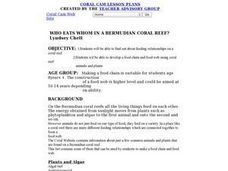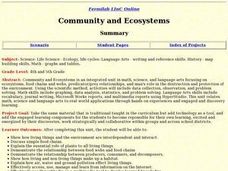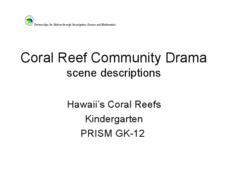Curated OER
Adaptations
Students identify features of animals that enable survival in particular environments and group animals on the basis of their similarities. They compare and contrast features of groups of animals.
Curated OER
Who Eats Whom in a Bermudian Coral Reef?
Young scholars will be able to find out about feeding relationships on a coral reef. They then will be able to develop a food chain and food web using coral reef animals and plants using the Coral Website.
Curated OER
Six Levels of Ecological Organization
Ninth graders describe the six levels of ecological organizations and give examples of each. They also differentiate between food chains and webs and identify trophic and consumer levels in food chain and food webs.
Curated OER
Explore Zone
In this food chain worksheet, students go outside to observe a small patch of grassy are. They list as many living and non-living things they can see then complete 5 short answer questions about their list.
Curated OER
What is an Ecological Footprint?
Introduce youngsters to the term ecological footprint. Learners identify ways in which humans affect the environment. They look at the problems associated with the use of natural resources, and focus on ways to preserve natural...
University of Georgia
What's So Special about Bottled Drinking Water?
Is artesian water designed to be better, or is it just from wells similar to those in the city of Artesium? This experiment looks at many different types of bottled waters, including artesian. Using a soap mixture, scholars test to see...
Curated OER
Little Bees, Big Potential
After reading an article on the alfalfa leafcutting bee, learners chart its characteristics alongside those of the honeybee. Then they draw the leafcutter lifecycle. The article provides fascinating reading when studying the role of...
Curated OER
Internet Scavenger Hunt
Students use a computer and the internet to click on highlighted words to find certain answers. They then write the answer to the questions on paper. Finally, students choose one animal to write about. They research the animal on the...
Curated OER
Community and Ecosystems
Students complete a unit of lessons on ecosystems. They participate in online activities, create a diorama, write journal entries, and develop a Hyperstudio multimedia project on a selected ecosystem.
Curated OER
Basic Nutrition (Nutri/Food)
Students analyze the nutrition found in a food and compare it to the nutrition found in similar food. They compare the nutrition of different products and complete the student worksheet Pyramid Pizzazz. This can be done at the beginning...
Curated OER
Living Things Depend upon Each Other
Students research animals. They identify the animals' struggle for survival, and internalize the importance of preserving an ecosystem with animal life.They collect information and write a report on their findings. Additional cross...
Curated OER
Coral Reef Community Drama: Scene Description
Students are organized into groups and are assigned puppets according to what sea creature their group represents. In this reef lesson, students identify sea creatures according to their place in the food chain then discuss how these...
Curated OER
Cancer-Fighting Foods and Health
Students will locate designated URL's to learn more about cancer protective foods. They will inventory their own dietary habits and that of their family to see which of these foods they have eaten and which are regular parts of their diet.
Curated OER
Funky Food Farm
Students research about ways to keep food from spoiling. In this health science lesson, students design an experiment to keep the ice cubes from melting. They present their designs and results in class.
Curated OER
Science: Let's Be Molecules!
Students discover how molecules are in constant motion. Through a simple experiment of water containing food coloring, they observe the drops of coloring move even though the water is still. Role-playing as molecules, students stand up...
Curated OER
Is There Seaweed/Algae in Your Food?
Students discover that seaweed/algae is a small part of the resources the oceans provide. By investigating common household products, students discover that human senses are not enough to detect the presence of seaweed/algae in food.
Curated OER
Healthy Teeth
A simple, yet effective lesson on dental health is here for your young learners. In groups, your class will place eggs in cups that contain a variety of liquids and observe what happens to the color of the egg. They brush the egg with a...
Curated OER
National Oatmeal Month and Nutrition
January can be a time to delve into a science lesson about nutrition through a discussion of whole grains, like oatmeal.
Curated OER
Health, Health, Hurrah!
Third graders explain the importance of eating healthy food. In this health science lesson, 3rd graders construct a balanced menu for breakfast, lunch and dinner. They create a collage about it and share it with the class.
Curated OER
Importance of the Rain Forest
Students use the Internet to conduct a research project. In this rain forest lesson plan, students work in groups to research different parts of the rain forest. Students research climate, foods, house products and medicines. Each...
Curated OER
Do You Need What I Need?
Student identify the basic human needs. In this life science instructional activity, 3rd graders compare the needs of plants, animals and humans. They apply what they have learned by playing a survival team game.
Curated OER
Mix It Up : Colors
Fifth graders make predictions of the resulting colors when colors are mixed. In this colors lesson, 5th graders discuss vocabulary related to mixing colors. Students are asked to paint a picture of five colors from two colors of...
Curated OER
Plants and Animals, Partners in Pollination
Students participate in multiple hands-on activities to explore reproduction and pollination. In groups, using a cotton swab and powder, students simulate being pollinators and plants. They name the parts of the flowers and the function...
Curated OER
Bird Buffet
Fifth graders investigate how birds use their beaks. In this agriculture lesson, 5th graders use tools to simulate how birds gather food with their beaks. They then draw conclusions about certain types of beaks and what types of food a...

























